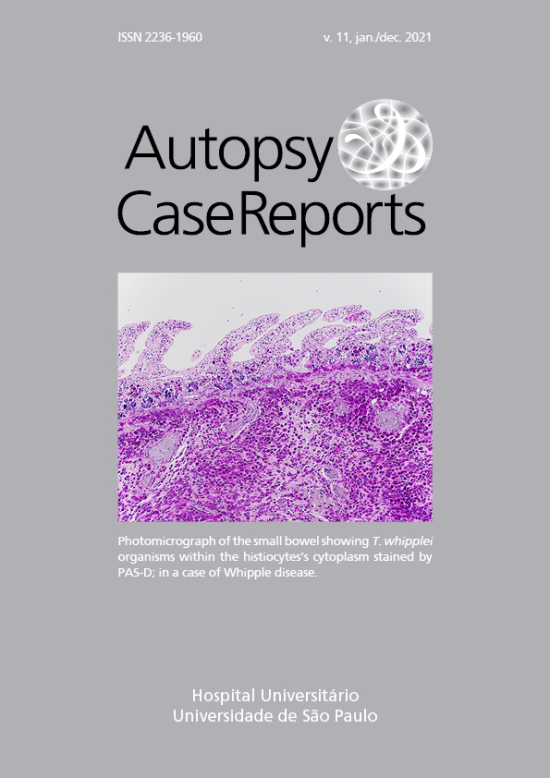Reactive airways dysfunction syndrome following inhalation of hydrogen chloride vapor
DOI:
https://doi.org/10.4322/acr.2021.266Keywords:
Bronchial Hyperreactivity, Respiratory Insufficiency, Respiratory Distress Syndrome, AdultAbstract
Hydrogen chloride is available commercially as an anhydrous gas or an aqueous solution, hydrochloric acid. Exposure to this gas has been associated with the development of reactive airways dysfunction syndrome. However, there are few published reports. A 37-year-old woman developed progressive bronchospasm and acute respiratory failure after cleaning an enclosed space with an unknown concentration of hydrochloric acid gas from a cleaning substance. She had no prior history of asthma or atopy. Severe bronchospasm developed, leading to hypoxemia and diffuse interstitial infiltrates, necessitating orotracheal intubation and admission to the intensive care unit. Asthma-like symptoms such as cough, wheezing, and dyspnea; requiring bronchodilators, and repeated hospitalizations are persistent a year after the accident. Pulmonary function testing showed mild airflow obstruction.
Downloads
References
Brooks SM, Weiss MA, Bernstein IL. Reactive airways dysfunction syndrome (RADS). Persistent asthma syndrome after high level irritant exposures. Chest. 1985;88(3):376-84. http://dx.doi.org/10.1378/chest.88.3.376. PMid:4028848.
Cormier Y, Coll B, Laviolette M, Boulet LP. Reactive airways dysfunction syndrome (RADS) following exposure to toxic gases of a swine confinement building. Eur Respir J. 1996;9(5):1090-1. http://dx.doi.org/10.1183/09031936.96.09051090. PMid:8793474.
Varney VA, Evans J, Bansal AS. Successful treatment of reactive airways dysfunction syndrome by high-dose vitamin D. J Asthma Allergy. 2011;4:87-91. http://dx.doi.org/10.2147/JAA.S19107. PMid:22034572.
Agency for Toxic Substances and Disease Registry (ATSDR). Managing Hazardous Materials Incidents (MHMI). Hydrogen chloride. 2001 [cited 2020 Nov 20]. Available from: https://www.atsdr.cdc.gov/MHMI/mmg173.pdf
Permanent Committee on Technology. Safety Japan Soda Industry Association. Safe handling of hydrochloric acid. Tokyo: JSIA; 2006 [cited 2020 Nov 20]. Available from: http://www.jsia.gr.jp/data/handling_02e.pdf
National Research Council (US). Subcommittee on Rocket-Emission Toxicants. Assessment of exposure-response functions for rocket-emission toxicants. Washington (DC): National Academies Press (US); 1998. Appendix D, Acute toxicity of hydrogen chloride. Available from: https://www.ncbi.nlm.nih.gov/books/NBK230426/
Sentry Air Systems, Inc. Hydrochloric acid vapor, mist, and fume inhalation health risks. 2017 [cited 2020 Nov 20]. Available from: https://www.sentryair.com/blog/chemical-fume-control/hydrochloric-acid-vapor-mist-and-fume-inhalation-health-risks/
National Research Council (US). Committee on Emergency and Continuous Exposure Guidance Levels for Selected Submarine Contaminants. Emergency and continuous exposure guidance levels for selected submarine contaminants. Washington (DC): National Academies Press (US); 2009. (vol. 3).
Bull S. Hydrogen chloride/hydrochloric acid: toxicological overview. Health Protection Agency; 2007 [cited 2020 Nov 20]. Available from: https://assets.publishing.service.gov.uk/government/uploads/system/uploads/attachment_data/file/337689/hpa_hydrogen_chloride_toxicological_overview_v1.pdf
De Lange DW, Meulenbelt J. Do corticosteroids have a role in preventing or reducing acute toxic lung injury caused by inhalation of chemical agents? Clin Toxicol. 2011;49(2):61-71. http://dx.doi.org/10.3109/15563650.2011.553196. PMid:21370942.
Boyce SH, Simpson KA. Hydrochloric acid inhalation: who needs admission? J Accid Emerg Med. 1996;13(6):422-4. http://dx.doi.org/10.1136/emj.13.6.422. PMid:8947805.
Ferguson ND, Fan E, Camporota L, et al. The Berlin definition of ARDS: an expanded rationale, justification, and supplementary material. Intensive Care Med. 2012;38(10):1573-82. http://dx.doi.org/10.1007/s00134-012-2682-1. PMid:22926653.
Stevens B, Koenig JQ, Rebolledo V, Hanley QS, Covert DS. Respiratory effects from the inhalation of hydrogen chloride in young adult asthmatics. J Occup Med. 1992;34(9):923-9. PMid:1447599.
Kaplan HL, Anzueto A, Switzer WG, Hinderer RK. Effects of hydrogen chloride on respiratory response and pulmonary function of the baboon. J Toxicol Environ Health. 1988;23(4):473-93. http://dx.doi.org/10.1080/15287398809531129. PMid:3129573.
Brower RG, Matthay MA, Morris A, Schoenfeld D, Thompson BT, Wheeler A. Ventilation with lower tidal volumes as compared with traditional tidal volumes for acute lung injury and the acute respiratory distress syndrome. N Engl J Med. 2000;342(18):1301-8. http://dx.doi.org/10.1056/NEJM200005043421801. PMid:10793162.
Boulet LP. Increases in airway responsiveness following acute exposure to respiratory irritants. Reactive airway dysfunction syndrome or occupational asthma? Chest. 1988;94(3):476-81. http://dx.doi.org/10.1378/chest.94.3.476. PMid:2842114.
Department for Environment, Food and Rural Affairs, Scottish Executive, National Assembly of Wales, Department of the Environment in Northern Ireland. Guidelines for halogens and hydrogen halides in ambient air for protecting human health against acute irritancy effects. United Kingdom: Royal Commission on Environmental Pollution; 1998 [cited 2020 Nov 20]. Available from: https://webarchive.nationalarchives.gov.uk/20060716141118/http://www.defra.gov.uk/environment/airquality/aqs/halogens/fullreport.pdf
Brooks SM, Hammad Y, Richards I, Giovinco-Barbas J, Jenkins K. The spectrum of irritant-induced asthma: sudden and not-so-sudden onset and the role of allergy. Chest. 1998;113(1):42-9. http://dx.doi.org/10.1378/chest.113.1.42. PMid:9440566.
Lemière C, Malo JL, Boutet M. Reactive airways dysfunction syndrome due to chlorine: sequential bronchial biopsies and functional assessment. Eur Respir J. 1997;10(1):241-4. http://dx.doi.org/10.1183/09031936.97.10010241. PMid:9032521.
Cockcroft DW. Environmental causes of asthma. Semin Respir Crit Care Med. 2018;39(1):12-8. http://dx.doi.org/10.1055/s-0037-1606219. PMid:29427981.
Chan-Yeung M. Assessment of asthma in the workplace: ACCP consensus statement. Chest. 1995;108(4):1084-117. http://dx.doi.org/10.1378/chest.108.4.1084. PMid:7555124.
Gautrin D, Boulet LP, Boutet M, et al. Is reactive airways dysfunction syndrome a variant of occupational asthma? J Allergy Clin Immunol. 1994;93(1):12-22. http://dx.doi.org/10.1016/0091-6749(94)90228-3. PMid:8308178.
Downloads
Published
Issue
Section
License
Copyright (c) 2021 Autopsy and Case Reports

This work is licensed under a Creative Commons Attribution 4.0 International License.
Copyright
Authors of articles published by Autopsy and Case Report retain the copyright of their work without restrictions, licensing it under the Creative Commons Attribution License - CC-BY, which allows articles to be re-used and re-distributed without restriction, as long as the original work is correctly cited.



